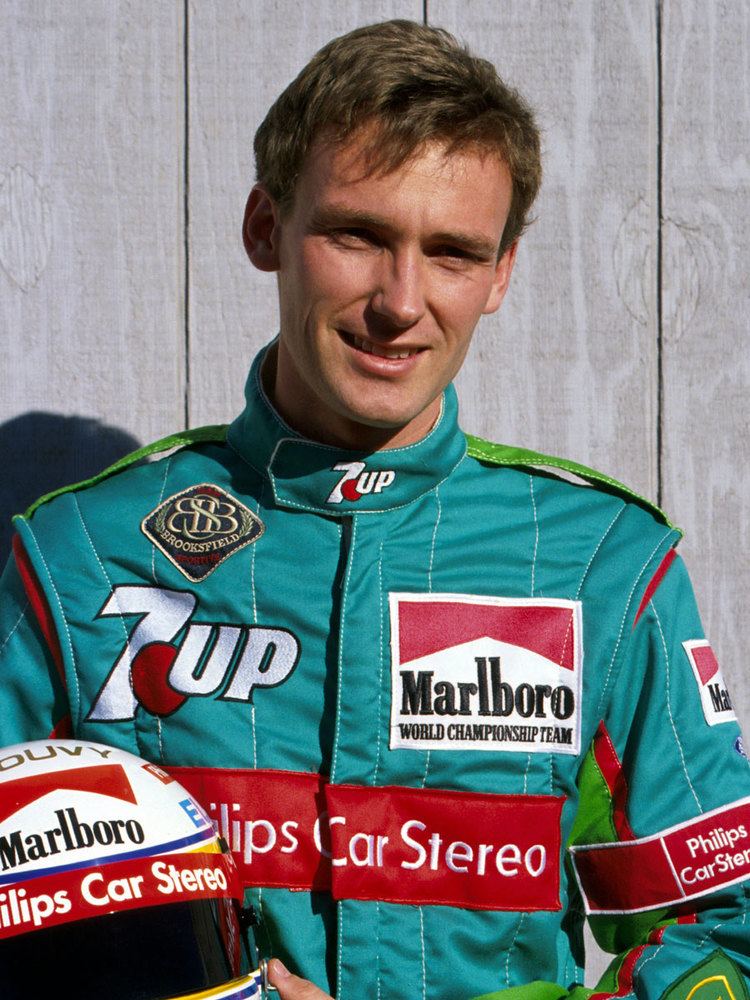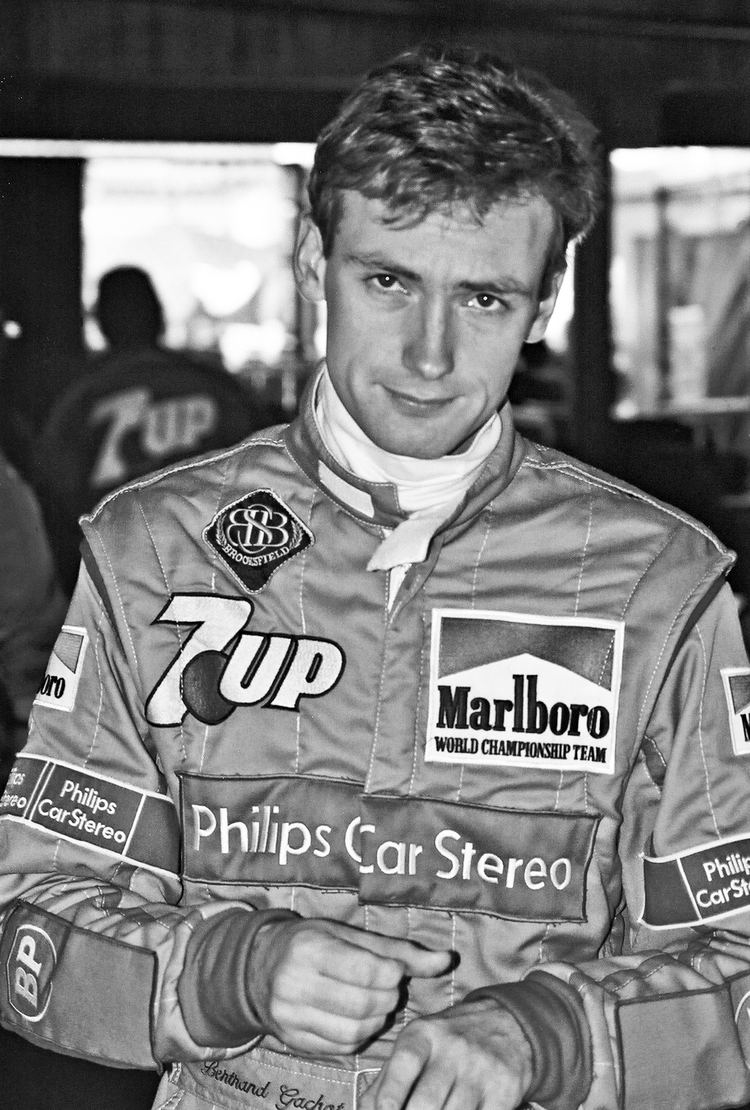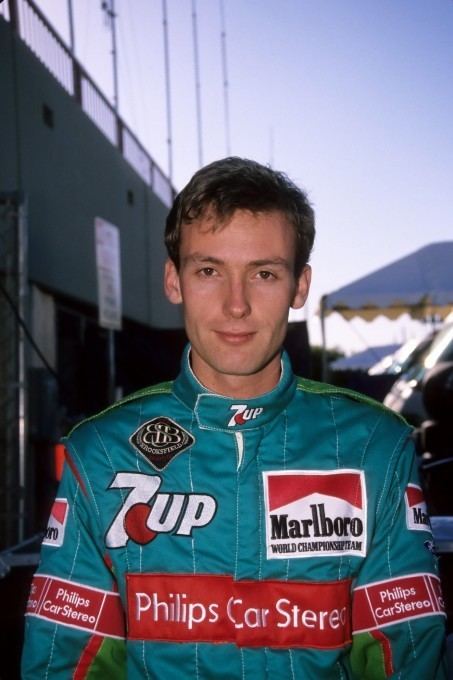Name Bertrand Gachot Wins 0 | Championships 0 Entries 84 (47 starts) Role Racing driver | |
 | ||
Born 23 December 1962 (age 62) Luxembourg, Luxembourg ( 1962-12-23 ) Nationality Belgian (1989–1991) French (1992, 1994–1995) Similar People | ||
Active years 1989–1992, 1994–1995 | ||
Interview with f1 driver bertrand gachot
Bertrand Gachot (born 23 December 1962) is a French former racing driver.
Contents
- Interview with f1 driver bertrand gachot
- Bertrand gachot
- Career
- Formula One
- Nationality
- Complete International Formula 3000 results
- Complete Formula One results
- American Open Wheel racing results
- References

Bertrand gachot
Career

Gachot was born in Luxembourg on 23 December 1962, the son of a French European Commission official and a German mother. He began karting at the age of 15. In 1983 he attended Winfield School, a well-known racing-driving school in France. After this, he focused on his racing career, competing first in the Formula Ford 1600 series. By 1986, he had won the British Formula Ford championship.

In 1987, Gachot joined the British Formula 3 series, finishing second in the championship for the West Surrey Racing team. In 1988, he switched to the Formula 3000 series, and met with some success.
Formula One

Gachot was considered one of the sport's most promising young drivers. He was signed by the newly formed Onyx team, having played a role in attracting the team's Moneytron sponsorship from the erratic Jean-Pierre Van Rossem and partnered with the experienced Stefan Johansson. The team was well-funded but late in getting their car prepared. As a new entrant they were consigned to the hugely competitive Friday morning prequalifying sessions and it wasn't until the French Grand Prix that Gachot made it onto the grid. There he impressed, starting 11th (two places ahead of Johansson) and ran in the points until battery problems dropped him to an eventual 13th and last. Despite qualifying for four of the next five events he was then fired by van Rossem after complaining about his lack of testing time; his private grievances were publicly aired in an Onyx press release and he was replaced with JJ Lehto. Gachot then found employment with the dying Rial team for the final two races of the season, failing to qualify their ageing chassis for either race. The team folded over the winter.
1990 was initially more promising as he switched to the Coloni team. The small Italian outfit had signed an exclusive deal with Subaru to use their new Carlo Chiti-designed and Motori Moderni-built 1235 flat-12 engine and Gachot was selected to drive the sole entry. However, the engine was overweight and underpowered, resulting in an ill-handling car that rarely ran for more than a few laps and Gachot didn't look like getting out of prequalifying. At the season opener in Phoenix, Gachot's gear selector rod broke on his first flying lap and he was unable to set a representative time. Subaru withdrew entirely after the British Grand Prix. After that the car ran with a Cosworth DFR engine and performances improved; the withdrawal of Onyx ironically promoted Gachot to the main qualifying sessions but the car still wasn't quick enough and he failed to make the grid all season.
Despite this Gachot was still highly regarded and was signed to lead the new Jordan Grand Prix team, well-backed by 7-Up and using Ford HB engines. The Gary Anderson designed 191 was a good car and after some initial reliability problems became a regular points scorer; Gachot finished 5th in Canada and 6th twice. He gathered considerable acclaim for his Grand Prix performances and for winning the Le Mans 24 Hours in a Mazda (with co-drivers Johnny Herbert and Volker Weidler). However, shortly after setting fastest lap at the Hungarian Grand Prix his season was cut short by a two-month prison stint, received for spraying CS gas on a London taxicab driver after a traffic altercation (his race seat was filled temporarily by then-unknown Michael Schumacher, making his Formula One debut). The incident prompted a campaign of support named Free Gachot organised by fellow Belgian racing driver Pascal Witmeur. This campaign involved flags, T-shirts worn by members of the public and racing drivers, graffiti in several locations of the Spa-Francorchamps track during the 1991 Belgian Grand Prix and prominent sponsorship on Witmeur's Formula 3000 car.
When he was finally released from prison after two months, he had missed four Grands Prix (including his home Grand Prix in Belgium). He travelled to Suzuka to try and retake his Jordan seat from Alessandro Zanardi. The team refused, though Gachot found employment with Larrousse, replacing the injured Éric Bernard for the Australian Grand Prix. He failed to qualify the unfamiliar car but impressed the team enough to be offered the seat for the following season.
The team ran a Robin Herd designed Venturi chassis with V12 Lamborghini engines but suffered reliability and financial problems throughout the season. Gachot and teammate Ukyo Katayama only managed 6 classified finishes between them from 31 starts, colliding with each other twice. Gachot scored the team's only point of the year for 6th place at Monaco. He also finished 4th for Mazda at Le Mans.
1993 saw him out of Formula 1. He raced for Dick Simon Racing in CART, placing 12th at the Molson Indy Toronto in a one-off drive and raced in Japanese touring car series for Honda while helping Keith Wiggins' Pacific team prepare to enter Formula One the following season. Gachot, after becoming a shareholder in the team, was signed to drive as number 1 alongside pay driver Paul Belmondo for the 1994 season. The PR01 was initially designed as the car for Reynard's proposed entry into the series, used 1992-spec Ilmor V10 engines and was not competitive. After Gachot outqualified Roland Ratzenberger to give the team its debut at the opening round the Pacifics would never beat fellow newcomers Simtek to the grid again, though a series of accidents in the sport led to several reduced entries and Gachot starting a further four races, failing to finish any. While he had the upper hand over Belmondo after the Canadian Grand Prix he would not make the grid again that season.
Gachot stayed with Pacific for 1995, with the new PR02 chassis, Cosworth ED engines and an influx of experienced personnel after a merger with the remains of Team Lotus. Due to there only being 26 entrants he was a guaranteed starter and the reliable package meant the car could at least finish races - though Gachot and teammate Andrea Montermini were largely left battling at the back of the grid. The team's finances were tight and Gachot stood down mid-season so infamous pay drivers Giovanni Lavaggi and Jean-Denis Délétraz could take his seat and bring some money to Pacific. After Délétraz's sponsors defaulted on payments, the team planned to rent the drive to Formula Nippon driver Katsumi Yamamoto for the two races in Japan, but he wasn't granted a superlicence, so Gachot retook the seat. Gachot also intended to hand the car over to the team's test driver Oliver Gavin for the season finale in Australia, but the Englishman was also refused a superlicence and the Belgian was forced back into the car, equalling the team's best result with 8th place (admittedly after most of the field had retired). It was Gachot's final Grand Prix as Pacific folded at the end of the season.
Gachot formed his own sports car team with the aim of participating in the 1996 24 Hours of Le Mans. The team entered a WR LM94 with factory support and engine from SsangYong, in what was a rare motorsport outing for the South Korean automotive manufacturer. The car participated in the pre-qualifying session but did not qualify for the race. The car was again entered in the Coupes d'Automne ACO, a 4-hour sports car race held at the Le Mans Bugatti circuit later in the 1996 season, where it qualified 3rd but did not finish.
He later drove in occasional sports car and GT races for a variety of manufacturers and privateers.
In later years, Gachot has concentrated on his business interests which include marketing Hype Energy, a high-energy beverage; he still keeps his contacts with Formula One and owns an F1 website.
Nationality
Born in Luxembourg as the son of a French European Commission official and a German mother, Gachot raced under more than one flag during his career. He initially competed with a Belgian FIA Super Licence, despite carrying a French passport. From the 1992 season onwards he changed to a French licence.
In a 1991 interview, Gachot said that "I am not really one nationality. I feel very much a European, but today I have to accept that a united Europe is not yet a reality. Certainly from a legal point of view." Gachot's helmet design features the circle of yellow stars on a blue background from the flag of Europe.
Complete International Formula 3000 results
(key) (Races in bold indicate pole position) (Races in italics indicate fastest lap)
Complete Formula One results
(key)
American Open Wheel racing results
(key)
